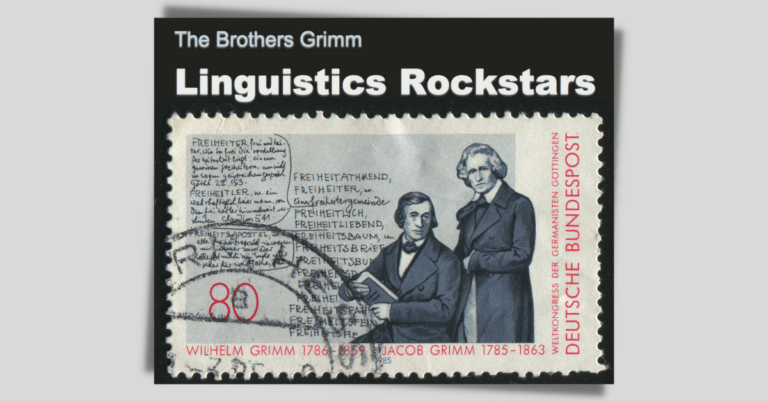- The Brothers Grimm are known for their fairy tales.
- They also wrote a German dictionary and grammar books.
- Jacob Grimm described “Grimm’s Law,” which explains why related words have p- and f-sounds, such as fire and pyro.
When I talk about the Grimm brothers, you probably think of “Grimm’s Fairy Tales” such as “Snow White,” “Rapunzel,” “Rumpelstiltskin,” “Sleeping Beauty,” and “Cinderella”; or maybe you think of the TV show “Grimm.” (As a complete aside, I recently read the original Cinderella, and it’s a lot darker than the Disney version.)
German grammar
The brothers’ names were Wilhelm and Jacob. Together, they collected and published folklore stories in the 1800s, but they were also interested in dictionaries—they worked on a German language dictionary for many years—and they were interested in linguistics. Jacob, in particular, published “The History of the German Language” and “German Grammar,” and he is the namesake of Grimm’s Law, which he first explained in that grammar book, “German Grammar.”
Grimm’s Law
Grimm’s Law describes how consonant sounds changed in a systematic way between very early languages called Proto-Indo-European and Proto-Germanic. Proto-Indo-European is the precursor to languages including Greek, Latin, Sanskrit, German, French, English, Gaelic, Hindi, Dutch, Russian, Pashto, and more. The list goes on and on, and Grimm, building on the work of Rasmus Rask, was the first person to describe the predictable pattern of changes you could see in certain consonant sounds as Proto-Indo-European became Proto-Germanic.
For example, Grimm realized that the p-sound in Proto-Indo-European tended to become an f-sound in Proto-Germanic. Grimm’s Law explains why we have the related words “fatherly” and “paternal,” “fish” and “Pisces,” and “fire” and “pyro.” It describes a lot of other sound changes too. The phenomenon Grimm described is also known as the first consonant shift, and it was a monumental discovery in early linguistics.
So the next time you watch “Snow White” with your kids or watch the TV show “Grimm,” remember that “Grimm’s Fairy Tales” may be what made the Grimm name famous in popular culture, but Jacob Grimm was also one of the giants of early linguistics.
Grimm’s Law is actually pretty complicated linguistics. Below is a YouTube video that helped me understand it better. Neal Whitman also helped me make sense of Grimm’s Law and come up with simple examples. He also pointed me to a second helpful video: Verner’s Law, Part 1 of 3 (The Grimm’s Law section begins around the 4:45 mark.)
Image courtesy of Shutterstock.




